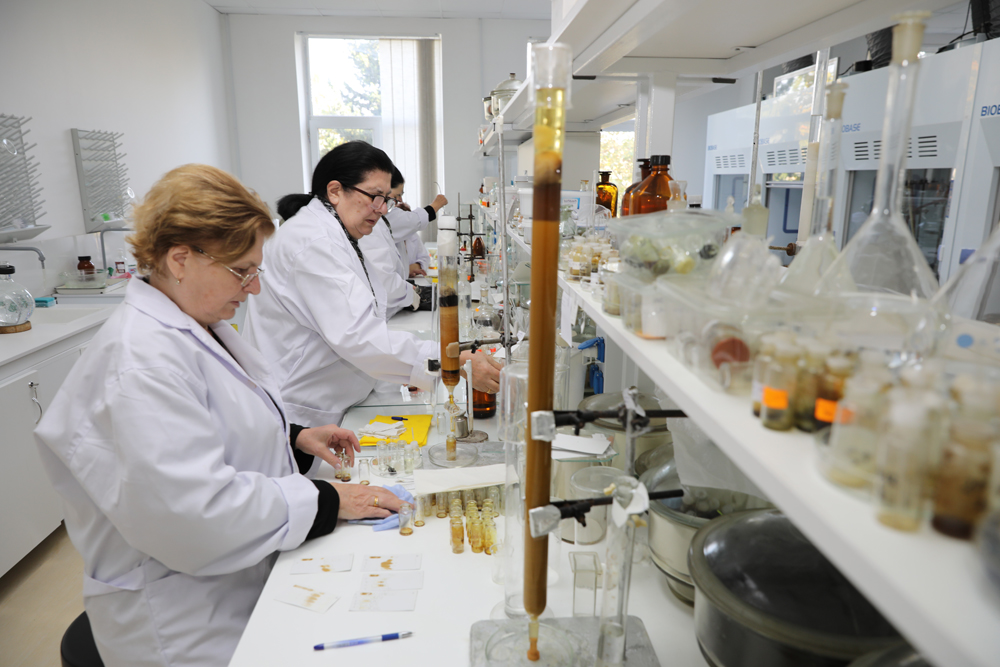Personnel: Principal scientific researcher N. Kavtaradze; Senior scientific researcher: K. Shalashvili, Senior scientific researcher T. Sagareishvili, Scientific researcher M. Sutiashvili
History: Phenolic compounds have researched in the Department of Phytochemistry since 1960 along with other naturally occurring biologically active compounds. Laboratory of Phenolic compounds, as an independent unit, was formed in 2005 after the restructuring of the scientific departments in the I. Kutateladze Institute of Pharmacochemistry. As an independent unit it was operated in 2005 - 2017. Nowadays it presents one of the scientific directions of the Department of Phytochemistry.
Goal: To study biologically active phenolic compounds of species from Georgian flora in order to create therapeutic drugs.
Sub Directions:
• Study of phenolic and cycloartane compounds of some prospective species of Georgian flora;
• Preliminary examination of pharmacobotanical expedition materials on the content of phenolic and cycloartane compounds.
• Search for prospective species containing phenolic and cycloartane compounds.
Tasks:
• In-depth chemical study of phenolic and cycloartane compounds of some prospective species of Georgian flora;
• A relatively in-depth chemical study of recently detected species rich in phenolic compounds in order to determine their prospects.
Research Methods:
• Physical;
• Chemical;
• Physicochemical (instrumental).
Education direction: curriculum development, training of PhD students.
Expertise: review of dissertations and scientific papers, expertise.
Main results of the study:
- Preliminary examination of more than 2000 species obtained by pharmacobotanical expeditions revealed a number species rich in content of flavonoids. These species are promising in terms of distribution areas and the use of the substances derived from them in medicine. The analysis of the research objects revealed that the same species in various regions differ with phenolic contents both quantitatively and qualitatively.
- The study some species of especially prominent genus Astragalus, Rhododendron, Salvia, Trifolium, Urtica, Ononis and others are carriing out.
- Taxonomic signs of Astragalus and Trifolium species of Georgian flora were ascertained.
- 482 individual compounds (flavones, flavonols, flavanonols, chalcones, aurones, pterocarpanes, tannins, triterpenes, cycloorthanes, phenolic acids and alcohols) are isolated and characterized - with different structure - 173, structurally new – 53.
- The gastroprotective activity of the substance obtained from overground parts of Ononis arvensis is established for the first time.
- Elaborated and implemented into production:
The original, officinal drug “Flaronin” - hypoazotemic, diuretic and hypoglycemic remedy;
“Rodopes” - antiviral ointment; remedy against diseases caused by Herpes simplex virus;
“Saturin” - hypoglycemic (Type II diabetes mellitus);
“Gingko-Bathi” - prophylaxis of atherosclerosis;
“Salbin” (capsules) - prophylaxis of atherosclerosis;
"Nunisi" – cosmetic ointment for feet;
“Salbey” (tablets) - a cough suppressant.
Chemical studies of promising biologically active substances are underway:
- Biologically active supplement – hypoazotemic substance from Pueraria hirsute ;
- Biologically active supplement – hypoazotemic, diuretic and hypocholesterinemic substance from Astragalus falcatus;
- Astragalegoside - individual flavonoid glycoside with diuretic activity;
- Isoastragalegoside - individual flavonoid glycoside with hypoazotemic and diuretic activity;
- “Borisozide” – substance with leucopoietic activity;
- Micranthoside - individual flavonoid glycoside with antioxidant and proliferative-stimulating properties;
- TG-1 - individual flavonoid with cardiotonic activity;
- Cardio-CA – sum of cycloartanes with hypocholesterinemic and cardiotonic activities;
- Fluid extract – for treatment prostate benign adenoma.
Elaborated standard substances:
- Flaronin-standard;
- Kaempferol-standard.
Pharmacopeia articles are elaborated and approved for officianl medicines:
- On plant raw materials;
- On active substances;
- On therapeutic forms.
Production regulations and technical conditions are elaborated as well.
Pharmacopeia article projects are elaborated for some prospective biologically active substances:
- On plant raw materials;
- On active substances;
- On the probable therapeutic forms.
Methods for the analysis of biologically active compounds and extractive substances have been developed.
Publications:
- Monographs - 9
- Scientific Articles - 205
- Conference abstracts - 188
- Copyright certificates and patents – 26


_1574338467.JPG)
